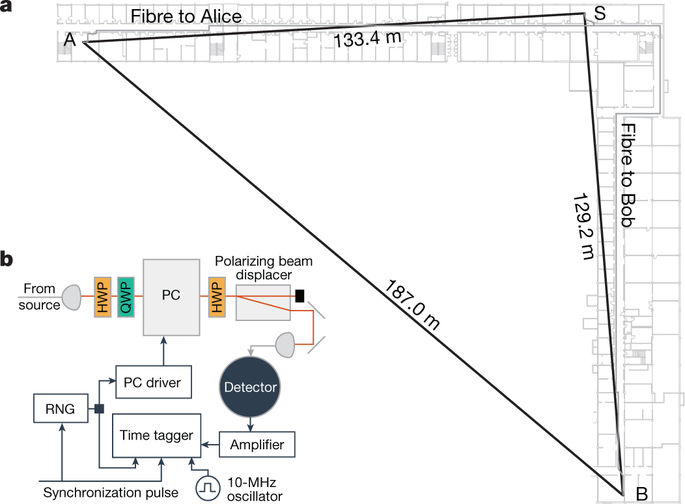Our official English website, www.x-mol.net, welcomes your feedback! (Note: you will need to create a separate account there.)
Experimentally generated randomness certified by the impossibility of superluminal signals
Nature ( IF 64.8 ) Pub Date : 2018-04-01 , DOI: 10.1038/s41586-018-0019-0 Peter Bierhorst , Emanuel Knill , Scott Glancy , Yanbao Zhang , Alan Mink , Stephen Jordan , Andrea Rommal , Yi-Kai Liu , Bradley Christensen , Sae Woo Nam , Martin J. Stevens , Lynden K. Shalm
Nature ( IF 64.8 ) Pub Date : 2018-04-01 , DOI: 10.1038/s41586-018-0019-0 Peter Bierhorst , Emanuel Knill , Scott Glancy , Yanbao Zhang , Alan Mink , Stephen Jordan , Andrea Rommal , Yi-Kai Liu , Bradley Christensen , Sae Woo Nam , Martin J. Stevens , Lynden K. Shalm

|
From dice to modern electronic circuits, there have been many attempts to build better devices to generate random numbers. Randomness is fundamental to security and cryptographic systems and to safeguarding privacy. A key challenge with random-number generators is that it is hard to ensure that their outputs are unpredictable1–3. For a random-number generator based on a physical process, such as a noisy classical system or an elementary quantum measurement, a detailed model that describes the underlying physics is necessary to assert unpredictability. Imperfections in the model compromise the integrity of the device. However, it is possible to exploit the phenomenon of quantum non-locality with a loophole-free Bell test to build a random-number generator that can produce output that is unpredictable to any adversary that is limited only by general physical principles, such as special relativity1–11. With recent technological developments, it is now possible to carry out such a loophole-free Bell test12–14,22. Here we present certified randomness obtained from a photonic Bell experiment and extract 1,024 random bits that are uniformly distributed to within 10−12. These random bits could not have been predicted according to any physical theory that prohibits faster-than-light (superluminal) signalling and that allows independent measurement choices. To certify and quantify the randomness, we describe a protocol that is optimized for devices that are characterized by a low per-trial violation of Bell inequalities. Future random-number generators based on loophole-free Bell tests may have a role in increasing the security and trust of our cryptographic systems and infrastructure.1,024 random bits that are uniformly distributed to within 10−12 and unpredictable assuming the impossibility of superluminal communication are generated and certified using a loophole-free Bell test.
中文翻译:

由超光速信号不可能证明的实验产生的随机性
从骰子到现代电子电路,已经有许多尝试构建更好的设备来生成随机数。随机性是安全和加密系统以及保护隐私的基础。随机数生成器的一个关键挑战是很难确保它们的输出是不可预测的1-3。对于基于物理过程的随机数生成器,例如嘈杂的经典系统或基本量子测量,需要一个描述基础物理的详细模型来断言不可预测性。模型中的缺陷会损害设备的完整性。然而,可以通过无漏洞的贝尔测试来利用量子非局域性现象来构建一个随机数生成器,该生成器可以产生任何对手都无法预测的输出,这些输出仅受广义物理原理(例如狭义相对论)的限制1– 11. 随着最近的技术发展,现在可以进行这种无漏洞的贝尔测试12-14,22。在这里,我们展示了从光子钟实验中获得的经过验证的随机性,并提取了 1024 个均匀分布在 10-12 范围内的随机位。根据任何禁止超光速(超光速)信号传输并允许独立测量选择的物理理论,无法预测这些随机位。为了证明和量化随机性,我们描述了一种针对具有低每次试验违反贝尔不等式特征的设备进行了优化的协议。未来基于无漏洞贝尔测试的随机数生成器可能会在提高我们的密码系统和基础设施的安全性和信任度方面发挥作用。 1,024 个随机位均匀分布在 10-12 范围内,并且假设超光速通信不可能是不可预测的使用无漏洞的贝尔测试生成和认证。
更新日期:2018-04-01
中文翻译:

由超光速信号不可能证明的实验产生的随机性
从骰子到现代电子电路,已经有许多尝试构建更好的设备来生成随机数。随机性是安全和加密系统以及保护隐私的基础。随机数生成器的一个关键挑战是很难确保它们的输出是不可预测的1-3。对于基于物理过程的随机数生成器,例如嘈杂的经典系统或基本量子测量,需要一个描述基础物理的详细模型来断言不可预测性。模型中的缺陷会损害设备的完整性。然而,可以通过无漏洞的贝尔测试来利用量子非局域性现象来构建一个随机数生成器,该生成器可以产生任何对手都无法预测的输出,这些输出仅受广义物理原理(例如狭义相对论)的限制1– 11. 随着最近的技术发展,现在可以进行这种无漏洞的贝尔测试12-14,22。在这里,我们展示了从光子钟实验中获得的经过验证的随机性,并提取了 1024 个均匀分布在 10-12 范围内的随机位。根据任何禁止超光速(超光速)信号传输并允许独立测量选择的物理理论,无法预测这些随机位。为了证明和量化随机性,我们描述了一种针对具有低每次试验违反贝尔不等式特征的设备进行了优化的协议。未来基于无漏洞贝尔测试的随机数生成器可能会在提高我们的密码系统和基础设施的安全性和信任度方面发挥作用。 1,024 个随机位均匀分布在 10-12 范围内,并且假设超光速通信不可能是不可预测的使用无漏洞的贝尔测试生成和认证。


























 京公网安备 11010802027423号
京公网安备 11010802027423号